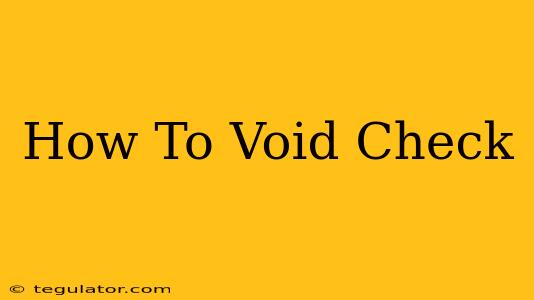So, you've written a check, but you need to cancel it. Don't worry, voiding a check is a common occurrence, and it's easier than you might think. This comprehensive guide will walk you through the process, explaining different methods and what to do afterward.
Understanding Why You Might Need to Void a Check
There are several reasons why you might need to void a check:
- Incorrect information: Maybe you misspelled the payee's name, wrote the wrong amount, or used the wrong date.
- Payment not needed: Perhaps the payment was made through a different method, or the transaction was canceled.
- Stopped Payment: If you've already stopped payment on the check (through your bank), you’ll want to void the original check to avoid confusion.
Whatever the reason, it's crucial to void a check properly to prevent fraud and maintain accurate financial records.
How to Void a Check: Step-by-Step
The process of voiding a check is straightforward:
- Write "VOID" across the face of the check: Use a pen and write "VOID" clearly and prominently across the entire check. Make sure it's impossible to alter or use the check. Don't be subtle!
- Sign the check: Sign the check in the same space you would normally endorse it. This adds an extra layer of security.
- Keep the voided check: Store the voided check with your other canceled checks and financial records. This is important for maintaining accurate accounting.
Important Considerations When Voiding Checks
- Never shred a voided check: While you might think shredding is sufficient, it's better to keep the voided check for your records. It provides a clear audit trail.
- Use a pen, not a pencil: Pencil markings can be easily erased, rendering the void ineffective.
- Don't try to erase or obscure information: Attempting to remove or hide information from the check can lead to more confusion.
- Inform your bank (if necessary): If you’re concerned about the voided check impacting your account, it is always advisable to contact your bank. They can advise and confirm the check is voided and will not impact your balance.
What to Do if a Check is Lost or Stolen
If a check is lost or stolen before it's cashed, you should immediately contact your bank to report it. They will likely help you stop payment and issue a new check.
Maintaining Accurate Financial Records
Voiding checks correctly is a vital aspect of responsible financial management. By following these steps, you can ensure your financial records are accurate and protected from potential fraud.
Frequently Asked Questions (FAQs)
- Can I void a check after it's been cashed? No, once a check has been cashed, you cannot void it.
- Do I need to notify anyone besides my bank? If the check was issued to a specific individual or business, consider notifying them that the check is voided to avoid any misunderstanding.
- What if I make a mistake voiding the check? If you're unsure about voiding it correctly, contact your bank for guidance.
By following these simple steps and keeping good records, you can confidently void checks and avoid potential problems. Remember, proactive financial management is key!

